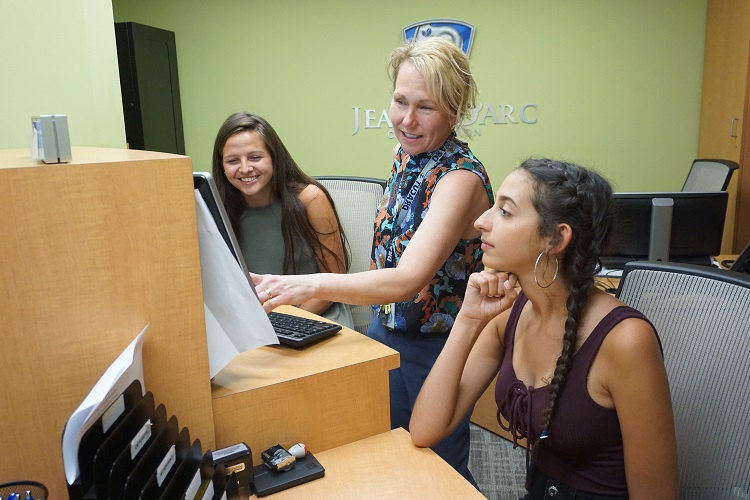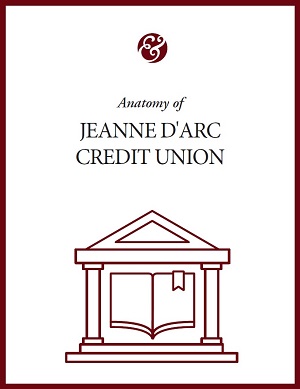CU QUICK FACTS
Jeanne D’Arc Credit Union
Data as of 03.31.18
HQ: Lowell, MA
ASSETS: $1.4B
MEMBERS: 85,269
BRANCHES:11
12-MO SHARE GROWTH: 3.9%
12-MO LOAN GROWTH: 13.5%
ROA: 0.96%
Jeanne D’Arc Credit Union ($1.4B, Lowell, MA) opened its first in-school branch at Dracut High School in 1997. At that time, the purpose of the branch wasn’t to provide financial literacy training to area high school students. It was a training ground for tellers.
In the two decades since, Jeanne D’Arc has opened in-school branches in two other high schools and implemented a full-scale financial education curriculum and skills training for the student staffers.
It’s evolved over time, says Anne Marie Sousa, the credit union’s vice president of marketing and financial education. We like our model right now.
In this Q&A, Sousa discusses the operation behind in-school branches, including how to earn school administration buy-in, recruit applicants, and develop future credit union employees.
Talk a bit about Jeanne D’Arc’s in-school branches.
Anne Marie Sousa: We have full-service branches in three high schools. We teach a full financial education course to the student staffers. Student staff also receive complete training in cash handling, teller duties, and member service. We also teach about non-financial topics, such as insurance. This is a topic that students don’t quite understand but need to know about.
Students elect to take this course through the school. They’re in the branch every day and take a pre- and post-assessment to measure what they’ve learned.

Jeanne D’Arc originally used in-school branches as a training ground for tellers. Here, financial education manager Heather Pintal helps student branch employees.
What else do they learn?
AMS: We cover employability skills as part of the curriculum. We have someone from our HR department spend a day at the high school and conduct mock interviews with every student who takes our class. We provide each student with feedback on how they can improve the things they can work on before they interview for a job and compliment them on their strengths.
How many credit union employees and high school students work at each branch?
AMS: Two of the branches have two credit union employees, the third has one. All three have a financial education manager the equivalent of a branch manager and the two larger schools with greater volumes have a second full-time employee.
In addition, we take two students per class period. In two of our schools, that means we have 14 kids per semester. The other school has a four-class-per-day block schedule, so we have eight per semester.
BEST PRACTICE: Make Time To Teach
Jeanne D’Arc is always on the lookout for teachable moments. Full-time staffers of the in-school branches take advantage of the downtime between transactions by offering lessons to student workers on things ranging from cash handling to customer service.
How do you choose which students to accept into the program?
AMS: It’s a bit different at each school. Our newest school wanted an application process to identify students who have an aptitude and a desire to learn more about the financial industry. The student has to apply and interview.
At another school, applicants must pass a previous course in finance, like accounting or entrepreneurship, with a B or higher to be considered for a class.
At the third school, it’s an elective that guidance counselors can recommend to students who seem like a good fit.
How do you earn buy-in from the high schools?
AMS: There’s been a shift over the years. Getting buy-in for financial education overall was a lot harder 10 years ago. I always say we’ve been teaching financial education since before it was the cool thing to do. Now, everybody wants to do it.
One of the high schools approached us. It knew we had other high school branches and knew of our reputation for financial education. It’s now an unbelievable partner that is supportive and excited to provide this opportunity for students.
Do the student staffers become part-time employees of the credit union?
AMS: It depends on our need, but we have maybe 10 or 15 people in officer positions here today who started off as high school tellers. Overall, we’ve probably hired 60 or 70 student tellers over the years. Some have come and gone, but many have stayed and made us their career.
BEST PRACTICE: Look To The Future
In-school branches provide a training ground for high school students and allow Jeanne D’Arc to build relationships by encouraging future credit union employees and creating life-long members.
How does your program add to the students’ educational experience?
AMS: There was a time, six or seven years ago, when the high schools shifted their focus to preparing kids for college and scaled back on their business curriculum. But not every kid is going to go to college, whether for financial reasons, lack of direction, or many other reasons. This is one way our branch helps. It gives kids the opportunity to learn skills they can put on their resume and get a job, whether it’s with us or somewhere else. If they’re going to college, they can get a part-time job.
When we first started, the schools saw us as a value to the students who weren’t going to college. I think schools are starting to realize it’s not all college prep or all job training. They have to offer both. That’s the reality of life.
Anatomy Of Jeanne D’Arc Credit Union
This article appeared as part of Callahan’s Anatomy Of A Credit Union series. Read more in the Jeanne D’Arc series today.

